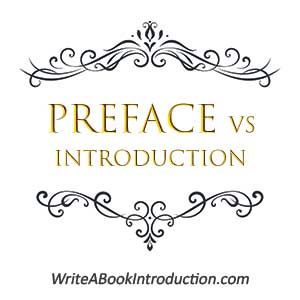What Is the Difference Between a Book Preface and an Introduction?
 This article about a book preface vs an introduction explains the difference between the two. It also explores their unique roles and content. Some books should have both. Understanding the differences between a preface and an introduction can help you structure your book effectively, and provide clarity to your audience. This article is part of a series about how to write a book introduction, written by a former literary agent who’s helped 400+ authors get literary agents and/or traditional publishers.
This article about a book preface vs an introduction explains the difference between the two. It also explores their unique roles and content. Some books should have both. Understanding the differences between a preface and an introduction can help you structure your book effectively, and provide clarity to your audience. This article is part of a series about how to write a book introduction, written by a former literary agent who’s helped 400+ authors get literary agents and/or traditional publishers.
Book Preface vs Introduction
A preface is written by the author to explain the book’s purpose, creation process, or background, often including acknowledgments. An introduction focuses on the book’s content, engaging readers by outlining its themes, structure, and relevance. Prefaces are personal and optional; introductions are reader-focused and often essential.
What is a Book Preface?
A book preface is a short section at the beginning of a book where the author addresses the reader directly. It provides context for why the book was written, its significance, and the process behind its creation.
Key Features of a Preface
- Author’s Perspective: The preface is written in the author’s voice, often in a conversational or reflective tone.
- Purpose: Explains the motivation for writing the book, the inspiration behind it, or the journey of its creation.
- Acknowledgments: May include thanks to individuals or institutions that supported the writing process.
- Optional Content: A preface is not essential for every book and is more common in nonfiction than fiction.
Examples of Preface Content
- Why the author chose the topic.
- Challenges faced during the writing process.
- Personal anecdotes or stories related to the book’s theme.
- Brief acknowledgments (though a dedicated “Acknowledgments” section may follow).
How Is a Book Preface Different Than an Introduction?
Unlike a preface that focuses on the author’s personal journey, an introduction focuses on the subject matter of the book. An introduction provides an overview of the book’s content, its structure, and its purpose for the reader.
Key Differences Between a Preface and an Introduction
- Focus: A preface focuses on the author’s journey and motivation; a book introduction focuses on the reader’s journey and expectations.
- Tone: The tone of a preface is reflective and personal; the tone of an introduction is informative and engaging.
- Purpose: The purpose of a preface is to explain why the book was written; the purpose of an introduction is to explain what the book is about.
- Content: The content of a preface includes the background, acknowledgments, and process; the content of an introduction includes the main theme, structure, and relevance.
- Placement: If a book includes a preface, it should appear before the introduction.
- Essential: A preface is optional; an introduction is necessary or preferable.
When to Use a Preface
A preface is helpful if you want to:
- Share your personal connection to the topic.
- Explain the circumstances or inspiration behind the book.
- Provide context for the book’s creation, such as research or collaboration.
- Acknowledge people or organizations that contributed to the project.
When to Use an Introduction
An introduction is essential if you want to:
- Clearly outline what your book is about and who it’s for.
- Provide a roadmap for the book’s structure.
- Set expectations for the reader about what they’ll gain or learn.
- Establish the importance of the book’s topic or arguments.
Do You Need a Book Preface and an Introduction?
Some books include both a preface and an introduction, but it’s not always necessary. Here’s when you might include both:
- Nonfiction Books: A preface can provide personal context or a backstory, while the introduction focuses on the book’s purpose and content.
- Academic or Research-Based Books: A preface might explain the research process, while the introduction outlines the scope and key findings.
For fiction books, a preface is rare, and an introduction is typically unnecessary unless the story requires some explanatory context.
Examples of Books with Prefaces and Introductions
- Nonfiction Example:
Sapiens: A Brief History of Humankind by Yuval Noah Harari - Preface: Harari discusses the origin of the book and acknowledges contributors.
- Introduction: Provides a broad overview of the book’s key themes and historical approach.
- Fiction Example:
Frankenstein by Mary Shelley - Preface: Shelley shares the story’s inspiration and the process of its creation.
- Introduction: Later editions include introductions by editors or scholars contextualizing the book.
Conclusion – Book Preface vs Introduction
The preface and introduction serve different purposes, but both play vital roles in framing a book for the reader. The preface offers a glimpse into the author’s journey, while the introduction focuses on engaging the reader and explaining the book’s content. Understanding these distinctions ensures your book starts with clarity, purpose, and impact, creating a strong foundation for the journey ahead.
Now that you’ve read “Book Preface vs Introduction,” click here for the next article about how to write a book introduction, “Book Foreword vs Introduction.”


 This guide about
This guide about 